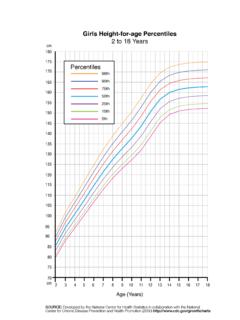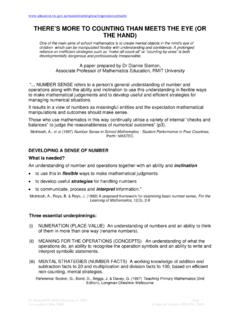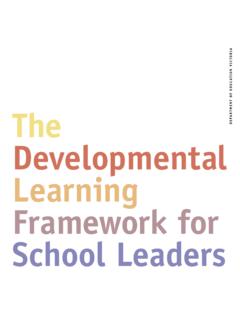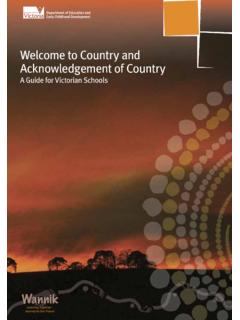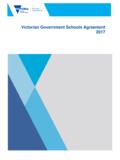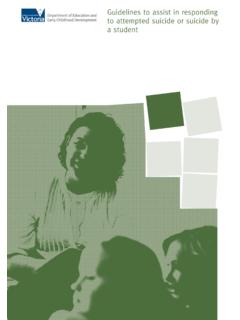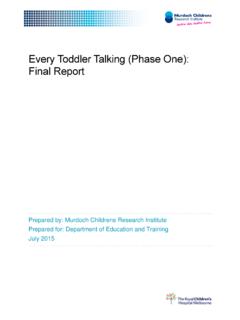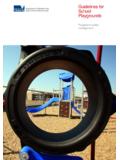Transcription of BUILDING QUALITY STANDARDS HANDBOOK
1 BUILDING QUALITY STANDARDS HANDBOOKMay 2021 State of Victoria (Department of Education and Training) 2021 The BUILDING QUALITY STANDARDS HANDBOOK is provided under a Creative Commons Attribution International licence. You are free to re-use the work under that licence, on the condition that you credit the State of Victoria (Department of Education and Training), indicate if changes were made and comply with the other licence terms, see: Creative Commons Attribution International The licence does not apply to: any images, photographs, trademarks or branding, including the Victorian Government logo and the DET logo.
2 And content supplied by third queries may be directed to INTRODUCTION What is the BUILDING QUALITY STANDARDS HANDBOOK ? Users of the document Structure The writing style of specifications Legislative hierarchy Departmental and government procedures Project Management Framework Local Jobs First - Victorian Industry Participation Policy Local Jobs First - Major Projects Skills Guarantee School infrastructure policies School and kindergarten area schedules Shelter In-Place for schools in bushfire-prone areas 92 EDUCATION VISION AND PHILOSOPHY Education vision and principles Victorian public sector values
3 Outcome areas Education Principles Learners and learning are central Schools are community hubs Diversity is celebrated A welcoming environment Early childhood facilities Overview of curriculum and pedagogy requirements The Victorian school curriculum Pedagogy requirements Early childhood education matters The role of infrastructure in effective education delivery Current context: The Education State 173 PLANNING Education vision and its impact on facility design Local schools are accessible to all Recognise Aboriginal culture in all new buildings and significant upgrades to Victorian government schools Integrate facilities for students with disabilities BUILDING for early childhood learning Design facilities that can adapt for changing purposes Universal design Master planning Urban context A sense of address and location Entry and exit requirements Site features and
4 Context Site planning Integration of shared facilities Emergency exits Site circulation Wayfinding and signage Pedestrian access Vehicle access Alternative transport access Provision of car parking Provision of bus parking Access for emergency vehicles Landscape planning Outdoor spaces and flagpoles Outdoor learning spaces School design principles Safety and security in design Sustainability Learning spaces BUILDING orientation Adjacency of spaces Potential for growth and flexibility relocatable buildings Construction planning Legislative requirements Workplace health and safety Child Safe STANDARDS Construction in bushfire-prone areas Services and maintainability review 35 CONTENTS4 SPECIAL FACTORS Process Common special factors Existing site and BUILDING conditions Climatic conditions Maintenance access and servicing Hazardous materials Multi-storey or higher-than-normal buildings Specialist and special developmental schools Furniture and equipment
5 Infrastructure works and services Items not generally considered special factors Location allowance Price escalation and fluctuation during documentation and construction Above-standard facilities Increased school construction rates 395 TECHNICAL SPECIFICATIONS Landscape architecture Soft landscaping Hard landscaping External equipment Shade areas Landscaping in bushfire-prone areas Wetlands Utilities and associated infrastructure Water Sewerage Stormwater drainage Natural gas Electricity Telecommunications Solar power systems BUILDING fabric Roof External walls and cladding Insulation and barriers Windows Glazing Doors Door and window hardware Security locking Ceilings Access hatches Stairs and ramps Toilet facilities Joinery and fixtures Bird-proofing Insect screens Termite protection BUILDING finishes External finishes Internal finishes Painting and applied
6 Finishes Acoustic engineering Demonstration of performance Airborne sound insulation between rooms Internal noise levels Reverberation External noise Structural engineering Site conditions and investigation Design life Substructure Superstructure Deflection Structural provision for access aids Civil engineering Stormwater drainage Access roads Pedestrian footpaths Mechanical services Heating Cooling Ceiling fans Electrical supply Gas supply Ventilation Dust extraction systems Ductwork Air grilles Pipework reticulation systems Noise and vibration Refrigeration Hydrotherapy pool mechanical services Electrical services Incoming electrical supply Main switchboards Cable reticulation Check and energy metering Underground pits and duct system General power outlets Electrical safety Lighting systems Information and communication technology ICT design and Information Management and Technology Division Structured cabling
7 Systems Network points required Wireless access points Pits and duct system Server room and IT equipment cabinets Voice communications (phones) Television distribution Audio-visual systems Public address system Sound system and intercom system for emergency purposes Hearing augmentation Security technology Security design Physical security Lighting Fencing Intruder alarm system functional requirements Electronic Access Control System CCTV monitoring Fire systems Fire hydrants Fire hose reels Pipework.
8 Valves and fittings Fire extinguishers Fire blankets Smoke detectors and sound alarms Smoke and fire doors Fire indicator panel Hydraulic services Domestic water services Tap outlets and fixtures Water storage Non-potable water services Potable and non-potable pressure-boosting pumps Heated water Heated water systems Sewer systems and sanitary plumbing Trade waste system Vertical transportation 1336 BUILDING HANDOVER AND COMPLETION Commissioning and tuning Essential safety measures Manual and logbook BUILDING operations and maintenance Training Update triggers Termites 1377 GLOSSARY 138 APPENDIX 141 INTRODUCTION17 | BUILDING QUALITY STANDARDS What is the BUILDING QUALITY STANDARDS HANDBOOK ?
9 Users of the documentThe BQSH is primarily used by architects and designers. Where the term project consultants is used, it refers to architects and designers. Secondary users include VSBA officers, regional offices, portfolio managers and school staff, who may use the BQSH for asset management and planning purposes. StructureThe BQSH has five distinct sections. Each is to be read in conjunction with additional and external information referenced in each section, to build a complete understanding of the specific considerations for design of Victorian government schools.
10 1 INTRODUCTIONThe five sections are: INTRODUCTIOND escribes the purpose of this document and how it is to be used by project consultants to develop designs for capital projects at Victorian government schools. EDUCATION VISION AND PHILOSOPHYD etails DET s vision, values and mission Helps readers understand the core business of DET and the VSBA, and the need for project consultants to support DET s vision. PLANNINGD etails the principles that influence the planning stages of school BUILDING design. Provides insight to requirements to be considered before the construction phase of capital projects.
